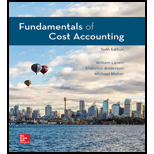
Fundamentals of Cost Accounting
6th Edition
ISBN: 9781260708783
Author: LANEN, William
Publisher: MCGRAW-HILL HIGHER EDUCATION
expand_more
expand_more
format_list_bulleted
Question
Chapter 10, Problem 70P
a.
To determine
Compute the profit of each for determining whether or not Company I should use new material or improve quality.
b.
To determine
Determine the other nonfinancial and qualitative factors that should be considered in making a decision.
Expert Solution & Answer
Want to see the full answer?
Check out a sample textbook solution
Students have asked these similar questions
Calculate the total assets
Belle Garments manufactures customized T-shirts for football teams. The business uses a perpetual
inventory system and has a highly labour-intensive production process, so it assigns manufacturing
overhead based on direct labour cost. The business operates at a profit margin of 33⅓% on sales.
Belle Garments expects to incur $2,205,000 of manufacturing overhead costs and estimated direct
labour costs of $3,150,000 during 2025.
At the end of December 2024, Belle Line Garments reported work in process inventory of $93,980 -
Job FBT 101 - $51,000 & Job FBT 102 - $42,980
The following events occurred during January 2025.
i) ii) Purchased materials on account, $388,000. The purchase attracted freight charges of $4,000
Incurred manufacturing wages of $400,000
iii) Requisitioned direct materials and used direct labour in manufacturing.
Job #
Direct Materials
Direct Labour
101
70,220
61,200
102
97,500
115,600
103
105,300
78,200
104
117,000
85,000
iv) Issued indirect materials…
Compute a shedule of deductible expenses
Chapter 10 Solutions
Fundamentals of Cost Accounting
Ch. 10 - How are activity-based costing and activity-based...Ch. 10 - Can activity-based management be implemented...Ch. 10 - Prob. 3RQCh. 10 - What are some ways in which customers affect a...Ch. 10 - How is computing the cost of customers the same as...Ch. 10 - Prob. 6RQCh. 10 - Prob. 7RQCh. 10 - Under what conditions should the cost of excess...Ch. 10 - In what ways does quality affect cost?Ch. 10 - What are the four categories in a cost of quality...
Ch. 10 - Prob. 11CADQCh. 10 - Prob. 12CADQCh. 10 - Consider a library that spends 25,000 to move most...Ch. 10 - Prob. 14CADQCh. 10 - Prob. 15CADQCh. 10 - You can get the cost of customers by first...Ch. 10 - Prob. 17CADQCh. 10 - Prob. 18CADQCh. 10 - Prob. 19CADQCh. 10 - Prob. 20CADQCh. 10 - Many if not most schools in the United States have...Ch. 10 - Prob. 22CADQCh. 10 - Prob. 23CADQCh. 10 - Prob. 25ECh. 10 - Prob. 26ECh. 10 - Prob. 27ECh. 10 - Cost Hierarchy for a Not-for-Profit Below are...Ch. 10 - Prob. 29ECh. 10 - Driver Identification Below are various activities...Ch. 10 - Activity-Based Costing of Customers Marvins...Ch. 10 - Activity-Based Costing of Customers Rock Solid...Ch. 10 - Prob. 33ECh. 10 - Prob. 34ECh. 10 - Prob. 35ECh. 10 - Activity-Based Costing of Suppliers Hult Games...Ch. 10 - Prob. 37ECh. 10 - Activity-Based Costing of Suppliers Kinnear...Ch. 10 - Prob. 39ECh. 10 - Resources Used versus Resources Supplied Tri-State...Ch. 10 - Prob. 41ECh. 10 - Resources Used versus Resources Supplied Conlon...Ch. 10 - Prob. 43ECh. 10 - Prob. 44ECh. 10 - Prob. 45ECh. 10 - Prob. 46ECh. 10 - Assigning Cost of Capacity Mimis Fixtures...Ch. 10 - Assigning Cost of Capacity Curts Casting...Ch. 10 - Prob. 49ECh. 10 - Costs of Quality The following represents the...Ch. 10 - Prob. 51ECh. 10 - Costs of Quality Nuke-It-Now manufactures...Ch. 10 - Prob. 53ECh. 10 - Cost of Quality: Environmental Issues Many...Ch. 10 - Prob. 55ECh. 10 - Prob. 56PCh. 10 - Activity-Based Reporting: Service Organization...Ch. 10 - Prob. 58PCh. 10 - Customer Profitability Carmel Company has a...Ch. 10 - Activity-Based Costing of Suppliers JFI Foods...Ch. 10 - Prob. 61PCh. 10 - Prob. 62PCh. 10 - Prob. 63PCh. 10 - Activity-Based Reporting: Manufacturing...Ch. 10 - Assigning Capacity Costs Cathy and Toms Specialty...Ch. 10 - Prob. 66PCh. 10 - Prob. 67PCh. 10 - Assigning Capacity Costs Mercia Chocolates...Ch. 10 - Prob. 69PCh. 10 - Prob. 70PCh. 10 - Prob. 71P
Knowledge Booster
Similar questions
- Lennox Designs sold office machinery for $15,500. Lennox originally purchased the machinery for $60,000, and depreciation through the date of sale totaled $49,000. What was the gain or loss on the sale of the machinery?arrow_forwardAnsarrow_forwardWhat is the Return on Equity on these accounting question?arrow_forward
arrow_back_ios
SEE MORE QUESTIONS
arrow_forward_ios
Recommended textbooks for you
- Principles of Accounting Volume 2AccountingISBN:9781947172609Author:OpenStaxPublisher:OpenStax College
 Cornerstones of Cost Management (Cornerstones Ser...AccountingISBN:9781305970663Author:Don R. Hansen, Maryanne M. MowenPublisher:Cengage Learning
Cornerstones of Cost Management (Cornerstones Ser...AccountingISBN:9781305970663Author:Don R. Hansen, Maryanne M. MowenPublisher:Cengage Learning Managerial Accounting: The Cornerstone of Busines...AccountingISBN:9781337115773Author:Maryanne M. Mowen, Don R. Hansen, Dan L. HeitgerPublisher:Cengage Learning
Managerial Accounting: The Cornerstone of Busines...AccountingISBN:9781337115773Author:Maryanne M. Mowen, Don R. Hansen, Dan L. HeitgerPublisher:Cengage Learning

Principles of Accounting Volume 2
Accounting
ISBN:9781947172609
Author:OpenStax
Publisher:OpenStax College

Cornerstones of Cost Management (Cornerstones Ser...
Accounting
ISBN:9781305970663
Author:Don R. Hansen, Maryanne M. Mowen
Publisher:Cengage Learning

Managerial Accounting: The Cornerstone of Busines...
Accounting
ISBN:9781337115773
Author:Maryanne M. Mowen, Don R. Hansen, Dan L. Heitger
Publisher:Cengage Learning